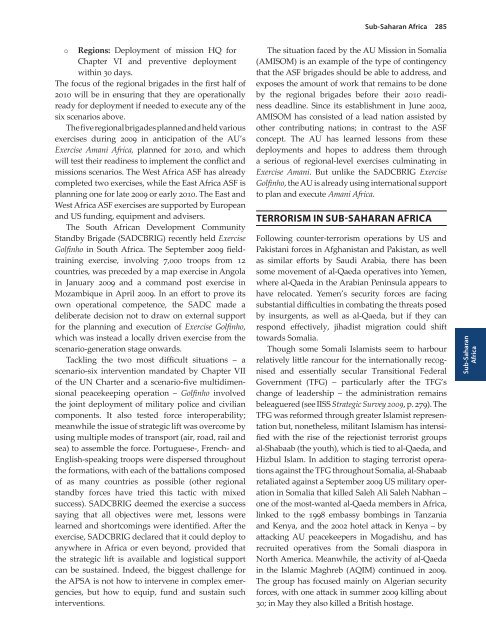You also want an ePaper? Increase the reach of your titles
YUMPU automatically turns print PDFs into web optimized ePapers that Google loves.
{ Regions: Deployment of mission HQ for<br />
Chapter VI and preventive deployment<br />
within 30 days.<br />
The focus of the regional brigades in the first half of<br />
2010 will be in ensuring that they are operationally<br />
ready for deployment if needed to execute any of the<br />
six scenarios above.<br />
The five regional brigades planned and held various<br />
exercises during 2009 in anticipation of the AU’s<br />
Exercise Amani Africa, planned for 2010, and which<br />
will test their readiness to implement the conflict and<br />
missions scenarios. The West Africa ASF has already<br />
completed two exercises, while the East Africa ASF is<br />
planning one for late 2009 or early 2010. The East and<br />
West Africa ASF exercises are supported by European<br />
and US funding, equipment and advisers.<br />
The South African Development Community<br />
Standby Brigade (SADCBRIG) recently held Exercise<br />
Golfinho in South Africa. The September 2009 fieldtraining<br />
exercise, involving 7,000 troops from 12<br />
countries, was preceded by a map exercise in Angola<br />
in January 2009 and a command post exercise in<br />
Mozambique in April 2009. In an effort to prove its<br />
own operational competence, the SADC made a<br />
deliberate decision not to draw on external support<br />
for the planning and execution of Exercise Golfinho,<br />
which was instead a locally driven exercise from the<br />
scenario-generation stage onwards.<br />
Tackling the two most difficult situations – a<br />
scenario-six intervention mandated by Chapter VII<br />
of the UN Charter and a scenario-five multidimensional<br />
peacekeeping operation – Golfinho involved<br />
the joint deployment of military police and civilian<br />
components. It also tested force interoperability;<br />
meanwhile the issue of strategic lift was overcome by<br />
using multiple modes of transport (air, road, rail and<br />
sea) to assemble the force. Portuguese-, French- and<br />
English-speaking troops were dispersed throughout<br />
the formations, with each of the battalions composed<br />
of as many countries as possible (other regional<br />
standby forces have tried this tactic with mixed<br />
success). SADCBRIG deemed the exercise a success<br />
saying that all objectives were met, lessons were<br />
learned and shortcomings were identified. After the<br />
exercise, SADCBRIG declared that it could deploy to<br />
anywhere in Africa or even beyond, provided that<br />
the strategic lift is available and logistical support<br />
can be sustained. Indeed, the biggest challenge for<br />
the APSA is not how to intervene in complex emergencies,<br />
but how to equip, fund and sustain such<br />
interventions.<br />
Sub-Saharan Africa<br />
285<br />
The situation faced by the AU Mission in Somalia<br />
(AMISOM) is an example of the type of contingency<br />
that the ASF brigades should be able to address, and<br />
exposes the amount of work that remains to be done<br />
by the regional brigades before their 2010 readiness<br />
deadline. Since its establishment in June 2002,<br />
AMISOM has consisted of a lead nation assisted by<br />
other contributing nations; in contrast to the ASF<br />
concept. The AU has learned lessons from these<br />
deployments and hopes to address them through<br />
a serious of regional-level exercises culminating in<br />
Exercise Amani. But unlike the SADCBRIG Exercise<br />
Golfinho, the AU is already using international support<br />
to plan and execute Amani Africa.<br />
TerroriSm in Sub-Saharan africa<br />
Following counter-terrorism operations by US and<br />
Pakistani forces in Afghanistan and Pakistan, as well<br />
as similar efforts by Saudi Arabia, there has been<br />
some movement of al-Qaeda operatives into Yemen,<br />
where al-Qaeda in the Arabian Peninsula appears to<br />
have relocated. Yemen’s security forces are facing<br />
substantial difficulties in combating the threats posed<br />
by insurgents, as well as al-Qaeda, but if they can<br />
respond effectively, jihadist migration could shift<br />
towards Somalia.<br />
Though some Somali Islamists seem to harbour<br />
relatively little rancour for the internationally recognised<br />
and essentially secular Transitional Federal<br />
Government (TFG) – particularly after the TFG’s<br />
change of leadership – the administration remains<br />
beleaguered (see IISS Strategic Survey 2009, p. 279). The<br />
TFG was reformed through greater Islamist representation<br />
but, nonetheless, militant Islamism has intensified<br />
with the rise of the rejectionist terrorist groups<br />
al-Shabaab (the youth), which is tied to al-Qaeda, and<br />
Hizbul Islam. In addition to staging terrorist operations<br />
against the TFG throughout Somalia, al-Shabaab<br />
retaliated against a September 2009 US military operation<br />
in Somalia that killed Saleh Ali Saleh Nabhan –<br />
one of the most-wanted al-Qaeda members in Africa,<br />
linked to the 1998 embassy bombings in Tanzania<br />
and Kenya, and the 2002 hotel attack in Kenya – by<br />
attacking AU peacekeepers in Mogadishu, and has<br />
recruited operatives from the Somali diaspora in<br />
North America. Meanwhile, the activity of al-Qaeda<br />
in the Islamic Maghreb (AQIM) continued in 2009.<br />
The group has focused mainly on Algerian security<br />
forces, with one attack in summer 2009 killing about<br />
30; in May they also killed a British hostage.<br />
Sub-Saharan<br />
Africa


